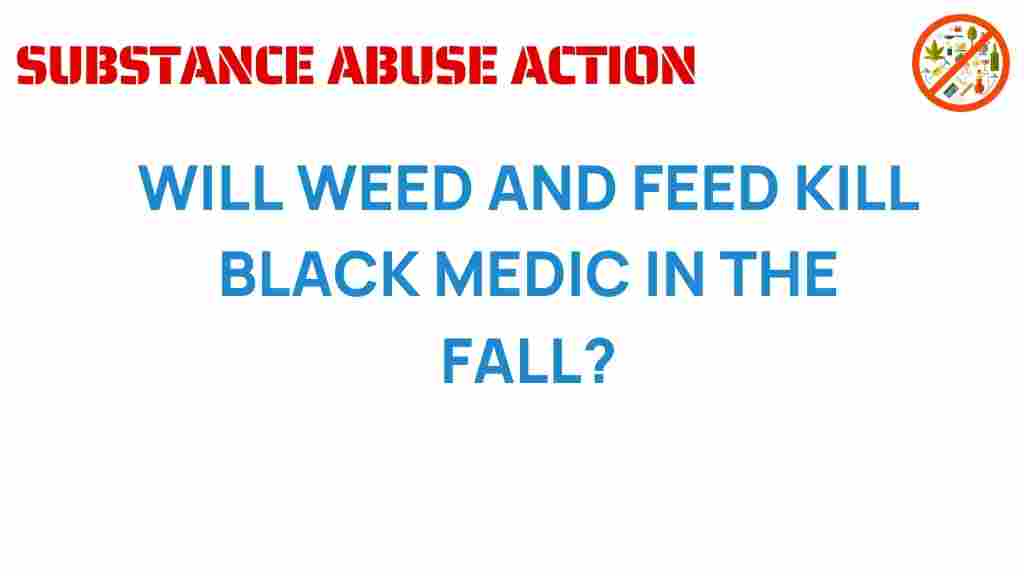The Battle for Black Medic: Will Weed and Feed Spell Disaster This Fall?
As fall approaches, many homeowners are faced with the challenge of maintaining a pristine lawn while battling unwanted plant species. One such species that often becomes a topic of contention is Black Medic (Medicago lupulina). This article explores the implications of using weed and feed products in lawn care, the environmental impact of these practices, and sustainable alternatives for managing invasive species like Black Medic.
Understanding Black Medic
Black Medic is a common lawn weed that thrives in various soil conditions and can quickly take over a lawn if not managed properly. This plant is known for its distinctive yellow flowers and clover-like leaves, making it a noticeable presence in many yards. While some might consider it an invasive species, others argue that it can contribute positively to soil health.
The Characteristics of Black Medic
- Growth Habit: Black Medic can grow up to 12 inches tall and spreads via seeds and creeping stems.
- Adaptability: It thrives in compacted soil and areas with poor grass growth.
- Benefits: Black Medic can fix nitrogen in the soil, potentially improving soil health when managed correctly.
The Role of Weed and Feed in Lawn Care
Weed and feed products are popular among homeowners for their dual action: they kill weeds while fertilizing the lawn. However, the use of these products raises questions about their effectiveness and environmental impact.
How Weed and Feed Products Work
Weed and feed products typically contain herbicides designed to target specific weeds like Black Medic while providing nutrients to grass. The active ingredients in these products can vary widely, impacting both efficacy and safety.
The Environmental Impact of Herbicides
Using herbicides in lawn care can have significant environmental repercussions:
- Water Contamination: Rain can wash herbicides into local waterways, affecting aquatic ecosystems.
- Non-target Species: Herbicides may harm beneficial insects and other plants, disrupting local biodiversity.
- Soil Health: Some chemicals can degrade soil quality, impacting microbial life essential for healthy lawns.
Fall Gardening: Is This the Right Time to Use Weed and Feed?
Fall is a critical time for lawn care. As temperatures drop, grass enters a state of dormancy, and weeds like Black Medic may start to proliferate. Deciding whether to use weed and feed products in the fall requires careful consideration.
Benefits of Fall Lawn Care
Maintaining your lawn in the fall can lead to:
- Stronger Roots: Fall fertilization encourages deep root growth, preparing the lawn for winter.
- Weed Control: Effective management of existing weeds before the winter can reduce spring outbreaks.
Risks of Using Weed and Feed in Fall
However, using these products in fall can also pose risks:
- Timing: Applying herbicides too late can negatively affect grass that is going dormant.
- Over-application: Miscalculating the amount needed can harm your lawn and surrounding environment.
Sustainable Practices for Managing Black Medic
Instead of relying solely on chemical solutions, homeowners can adopt sustainable practices to manage Black Medic and other invasive species effectively.
Alternative Strategies
- Manual Removal: Pulling Black Medic by hand or using a hoe can be effective, especially when the soil is moist.
- Mulching: Applying mulch can suppress weed growth while enriching the soil.
- Overseeding: Planting desirable grass species can help outcompete Black Medic for resources.
Improving Soil Health
Enhancing soil health is crucial for a thriving lawn. Consider the following sustainable practices:
- Composting: Adding organic matter improves soil structure and nutrient content.
- Crop Rotation: Altering planting patterns can disrupt weed growth cycles.
- Cover Crops: Planting cover crops in fall can prevent erosion and improve soil fertility.
Troubleshooting Common Lawn Care Issues
Even with the best practices, lawn care can be challenging. Here are some common issues and solutions:
Issue: Persistent Black Medic Growth
Solution: Regularly monitor your lawn and manually remove Black Medic before it seeds. Consider overseeding with a competitive grass variety.
Issue: Poor Grass Growth
Solution: Test soil pH and nutrient levels. Amend the soil as necessary to create the optimal environment for grass growth.
Issue: Negative Environmental Effects
Solution: Use organic alternatives to chemical herbicides and fertilizers. Explore natural weed control methods, such as vinegar or salt solutions, for targeted treatment.
Conclusion
The battle against Black Medic and other invasive species is ongoing, particularly as we head into the fall gardening season. While weed and feed products may offer a quick solution, their potential environmental impact cannot be overlooked. By adopting sustainable practices and focusing on soil health, homeowners can manage Black Medic effectively while preserving the environment.
For more information on sustainable lawn care practices, check out this resource on EPA’s guidelines.
Ultimately, the choice is yours: will you rely on chemical solutions, or will you embrace sustainable practices to foster a healthier lawn environment? The decision could spell the difference between a flourishing yard or a battle lost to invasive species.
For more tips on lawn care, visit our lawn care guide.
This article is in the category Health and created by SubstanceAbuseAction Team
